Nikon 16-85mm f/3.5-5.6G ED VR AF-S DX Nikkor Lens Review
Nikon 16-85mm f/3.5-5.6G ED VR AF-S DX Nikkor Performance
At 16mm sharpness in the centre of the frame is already outstanding at maximum aperture, and the clarity towards the edges of the frame is very good. Stopping the lens down a little results in increased sharpness towards the edges of the frame and peak quality across the frame is achieved at f/5.6 for this focal length.As is often the case with many high ratio zoom lenses, sharpness drops off a little as the lens is zoomed in. At 35mm the lens still performs well, with excellent sharpness in the centre and good clarity towards the edges at maximum aperture. Peak performance across the frame is achieved at f/8 for this focal length where sharpness across the frame is excellent.
Finally at 85mm, there is another slight drop in overall clarity, but the lens still performs well. The lens produces good sharpness across the frame at f/5.6 and very good sharpness at f/8.
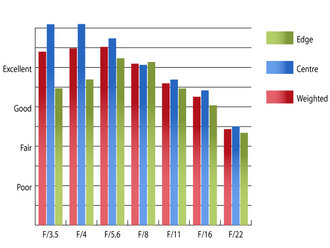 Resolution @ 16mm | 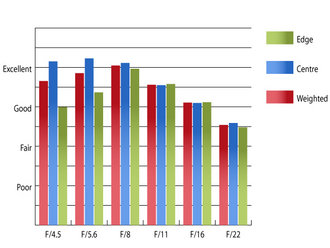 Resolution @ 35mm | |
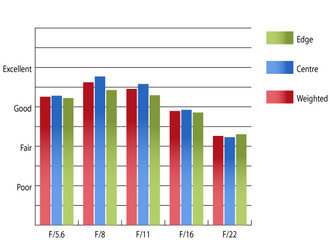 Resolution @ 85mm | How to read our chartsThe blue column represents readings from the centre of the picture frame at the various apertures and the green is from the edges. Averaging them out gives the red weighted column.The scale on the left side is an indication of actual image resolution. The taller the column, the better the lens performance. Simple. For this review, the lens was tested on a Nikon D300 using Imatest. |
Chromatic aberrations are well controlled, staying well below one pixel width throughout the zoom range. Fringing is at its strongest at 85mm towards the edges of the frame at f/5.6. Here Imatest recorded chromatic aberrations covering 0.95 pixel widths, which should be hard to spot, even in large prints or harsh crops from the edges of the frame.
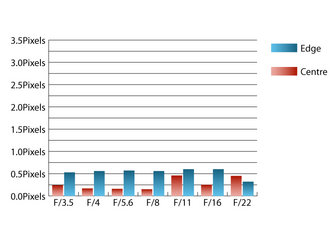 Chromatic aberrations @ 16mm | 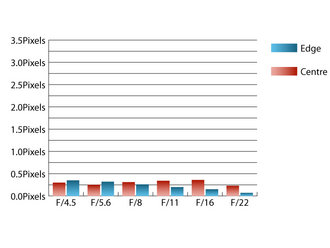 Chromatic aberrations @ 35mm | |
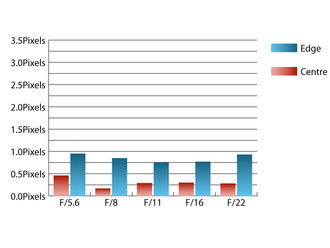 Chromatic aberrations @ 85mm | How to read our chartsChromatic aberration is the lens' inability to focus on the sensor or film all colours of visible light at the same point. Severe chromatic aberration gives a noticeable fringing or a halo effect around sharp edges within the picture. It can be cured in software.Apochromatic lenses have special lens elements (aspheric, extra-low dispersion etc) to minimize the problem, hence they usually cost more. For this review, the lens was tested on a Nikon D300 using Imatest. |
Falloff of illumination towards the corners of the frame is well enough controlled throughout the zoom range. At 16mm the corners are 1.5 stops darker than the image centre at maximum aperture and visually uniform illumination is achieved at f/5.6. At 85mm the corners are only 1 stop darker at f/5.6 and visually uniform illumination is achieved at f/8 for this focal length.
Distortion is often an issue with high ratio zooms and although the 3.56% level of barrel distortion at 16mm is quite pronounced, this level is quite low when compared with other similar zoom lenses. Imatest detected 0.993% pincushion distortion at 85mm, which may be noticeable in some circumstances. At either end of the zoom range the distortion pattern is uniform across the frame, which should make corrections in image editing software relatively straightforward.
A reasonably deep petal-shaped lens hood comes supplied with the lens, which does a reasonable job of keeping extraneous light from causing flare and loss of contrast in images. In use the lens is fairly resistant to flare with only very strong light sources in the frame causing any issues.
Add your message
Login required
Please login here or if you've not registered, you can register here. Registering is safe, quick and free.
Please login here or if you've not registered, you can register here. Registering is safe, quick and free.
photodo Stats
1102 lenses
428 MTF tests
74 in-depth photodo reviews
100+ users join each day
Help the lens community by reviewing or rating a lens today via our lens search
428 MTF tests
74 in-depth photodo reviews
100+ users join each day
Help the lens community by reviewing or rating a lens today via our lens search
Latest Lens Reviews
- Chinon 28mm f/2.8 Vintage Lens Review
- Canon EF 70-200mm f/4L IS II USM Lens Review
- Samyang AF 85mm f/1.4 EF Review
- Sigma 70mm f/2.8 DG Macro Art Review
- Samyang AF 24mm f/2.8 FE Review
- Meike 50mm f/1.7 Review
- Tamron 70-210mm f/4 Di VC USD Review
- Lensbaby Burnside 35mm f/2.8 Review
- Asahi Super Takumar 50mm f/1.4 Review
- Asahi Super-Multi-Coated Takumar 135mm f/3.5 Review
